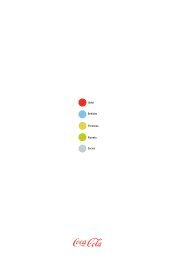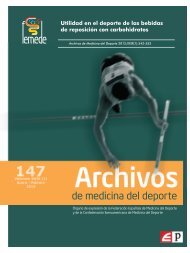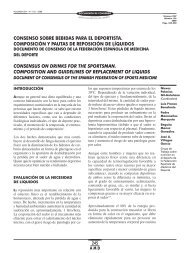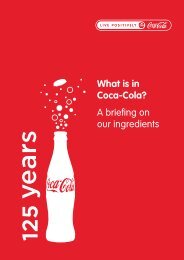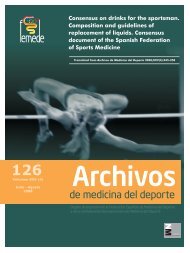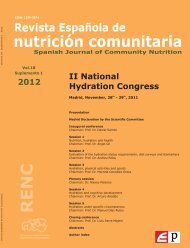athletes' medical information - Coca-Cola
athletes' medical information - Coca-Cola
athletes' medical information - Coca-Cola
You also want an ePaper? Increase the reach of your titles
YUMPU automatically turns print PDFs into web optimized ePapers that Google loves.
athletes’ <strong>medical</strong> <strong>information</strong><br />
Practical ways to assess<br />
and manage hydration<br />
Severe dehydration impairs performance and<br />
increases the risk of heat illness, but drinking<br />
too much can also be harmful or uncomfortable.<br />
Every athlete is different because they have<br />
different sweat losses and different<br />
opportunities to drink fluid during their workouts<br />
and events. You need a personal hydration plan,<br />
and YOU have to play a role in developing this.<br />
Remember that humans do not adapt to<br />
dehydration, but may learn to complain less<br />
about it. Three simple steps may help to guide<br />
your hydration practices.<br />
1. Start the session well hydrated. If you are<br />
passing urine less often than normal, you may<br />
be dehydrated. If urine colour becomes darker<br />
than what is normal for you, then you may not<br />
be drinking enough. Check your urine colour<br />
against the chart.<br />
Note that the aim should NOT be for your<br />
urine to be as pale as possible. Drinking too<br />
much can be uncomfortable and, if excessive,<br />
possibly harmful. The aim is to develop fluid<br />
practices over the day that keep pace with<br />
regular fluid needs and special losses from<br />
exercise or hot environments. As losses change,<br />
so should drinking practices. It makes sense to<br />
spread fluid intake over the day rather than<br />
trying to play catch up at the end. Drinking<br />
more than you need in the late part of the day<br />
can mean interrupted sleep due to toilet breaks.<br />
2. Develop a drinking plan for training and<br />
competition that is right for you. This should be<br />
based on several pieces of <strong>information</strong>, including<br />
your typical sweat losses, the opportunities to drink<br />
in your sport and feedback from comfort and thirst.<br />
Monitor your sweat losses and the success<br />
of your drinking plan during training sessions in<br />
different situations (see next page). How did you<br />
feel? How did you perform? What was your<br />
weight loss over the session? This should<br />
generally not exceed about 1-2% of body mass.<br />
If you lost more than this, you probably did not<br />
drink enough. Drink more next time. If you lost<br />
less, you might have drunk too much. Did it<br />
make you feel uncomfortable? Did you take<br />
time out to drink that was unnecessary?<br />
Drinking so much that you gain weight during<br />
competition is never likely to be a good idea. The<br />
only time you might need to do this is when you<br />
have been dehydrated at the start of the event.<br />
3. If you are a “salty sweater,” you may need<br />
drinks with more salt and may need more salt<br />
in food when sweat losses are high. To check<br />
whether you are a salty sweater, wear a black<br />
T-shirt in training and look for salt stains (white<br />
powder) under the arms and on the chest.<br />
High salt losses may be a contributing factor<br />
in some – but not all – cases of muscle<br />
cramps. Sports drinks with higher salt (sodium)<br />
levels (e.g., 300-500 mg sodium per 500 ml<br />
liquid) may help reduce the risk of cramps.<br />
12-113-COC_Paralymics_Booklet_20120718.indd 26<br />
7/18/12 4:29 PM





